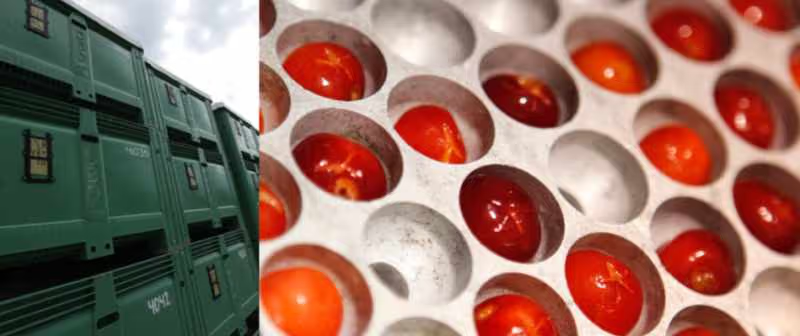Tree to Table | Vertical Integration in the Food Industry

The term Vertical Integration is used throughout the business world, but what does it really mean? How does it apply to the food industry? Does it really matter to consumers? Is there value in a vertically integrated supply chain? Research shows many potential benefits to vertical integration, especially in the food and ingredient industry.
What are Consumers Looking For?
There are many factors affecting consumers buying decisions, yet all are connect by one theme – trust. In recent years there has been a push towards greater transparency in the food industry. Consumers are more aware of the origin, ingredients, and processing of the products they purchase.
“Food transparency is a growing trend: consumers want to know where food comes from.” – IRi
Vertical integration removes the steps and mystery between the farm and the final product. This creates a simpler supply chain that creates a direct connection all the way back to the farm. This allows a business to “tell the story” of where the product came from, ultimately creating trust with the consumer.
What is Vertical Integration?
The simple definition of vertical integration is when one company controls more than one stage of the supply chain or production cycle. This could be a single company or a group of companies that are all under the same ownership.
There are two types of vertical integration... backward integration and forward integration. Backward integration is when a company controls their suppliers.
For example, a retailer that also controls a distributor and packer would be considered backward integration. Forward integration is when a company with the initial resource controls companies further down the supply chain. An example of forward integration would be a farm that controls processors and distributors.

Benefits of Vertical Integration for Ingredient Suppliers
As the consumer’s concern and desire to know more about their food continues to grow, the need for transparency increases. In a study published in January 2018, The Center for Food Integrity found that “only 25% strongly agree with the statement ‘I trust today’s food system’”. Let’s look at how vertical integration can positively impact consumers trust. The food industry is uniquely positioned to benefit from vertical integration because the safety and quality of every ingredient, no matter how small, is essential to the final product’s safety and quality.
Food Safety
Food safety is absolutely critical within the food industry. Not only is there an enormous effort required to create, track, and test the food safety program, but every time a change is made it requires additional effort to maintain the program.
Vertically integrated companies have a few key advantages in this area, one being that they work together closely on a long-term basis. A close working relationship creates a more stable environment as opposed to regularly switching suppliers. Vertically integrated companies also have complementary food safety programs, improving the communication and the ability to meet increasing food safety standards.
Traceability
Traceability comes down to systems and communication. When a company is vertically integrated, they are able to share information at a deeper level. Together with their sister companies, they can build systems where they connect vital information between the organizations. This can improve traceability, both in the detail of the trace, as well as in the time it takes to conduct the trace.
Innovation & Collaboration
Innovation and collaboration is potentially the most significant benefit of vertical integration. A vertically integrated organization is able to collaborate and creatively innovate with their sister- organizations at a deeper level than a non-vertically integrated group of companies. This results in more flexible and customized solutions that other companies are not able to provide.
Quality
Quality goes hand-in-hand with innovation. New innovations and techniques can improve the quality of the products.
A vertically integrated organization can share what would be considered “trade secrets” with their sister-companies. The ability to learn directly from each other ultimately helps to improve the overall quality.
Sustainability
Progress towards sustainability is driven by the vision within the company. A group of vertically integrated companies have closer communication and a more consistent vision between them. When an effort is made towards sustainability, it can move quicker, and go deeper than if there were multiple unrelated companies trying to make the same change.
Reliable Supply
A vertically integrated group of companies offer a more consistent and reliable supply of products. This is due to the strong connection between the organizations that gives the priority of supply to the sister-companies.
Why it all Matters
Creating trust with consumers is currently, and will become even more of, a necessity within the food industry. Aspects such as food safety, quality, and traceability will continue to be top priorities for food manufacturers and processors in order to build this trust. Vertically integrated companies are uniquely positioned to fill these needs today – and to lead the way in the future.
About Shoreline Fruit
A Vertically Integrated Tart Cherry Supplier
Shoreline Fruit is a grower owned, vertically integrated company that offers the finest products. With 50 years of history in the fruit industry, the Shoreline Fruit group of companies has become the largest tart cherry operation in North America.
Shoreline Fruit’s vertically integrated organization includes a cooperative of growers as well as dryers, pitters, packers, freezers, and storage facilities. From the planting of each sapling to the shipping of each order, the Shoreline Fruit family of companies works to provide every customer with a consistently superior product and experience.
Shoreline Fruit offers products including dried fruit, cherry concentrate, cherry juice, and nutraceuticals for the ingredient, commercial, and retail industries.

